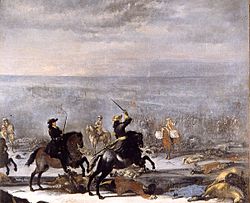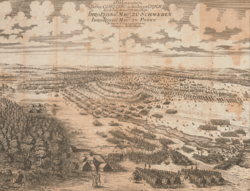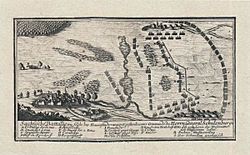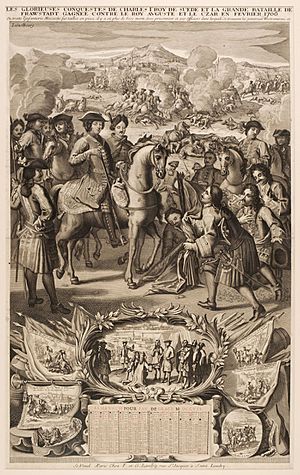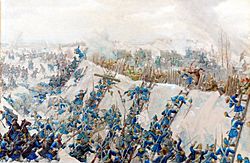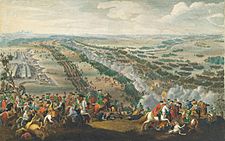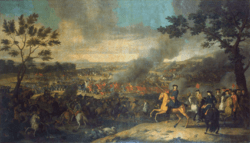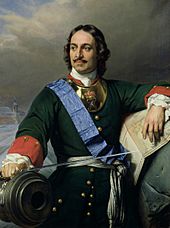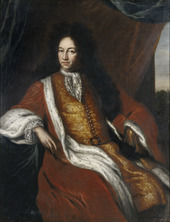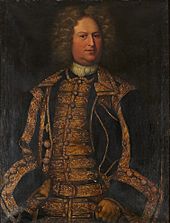Carl Gustav Rehnskiöld facts for kids
Quick facts for kids
Carl Gustav Rehnskiöld
|
|
|---|---|
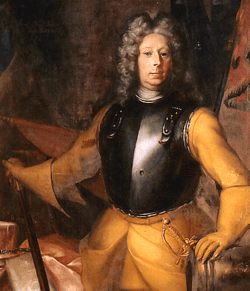
Carl Gustav Rehnskiöld by David von Krafft.
|
|
| Born | 6 August 1651 Stralsund, Swedish Pomerania |
| Died | 29 January 1722 (aged 70) Läggesta Inn outside of Mariefred, Södermanland, Sweden |
| Allegiance | |
| Service/ |
Cavalry Infantry |
| Years of service | 1673−1722 |
| Rank | Field Marshal (Fältmarskalk) |
| Unit | Närke-Värmland Regiment Queen Dowager of the Realm's Horse Life Regiment Uppland Regiment Svea Life Guards |
| Commands held | German Foot Life Regiment Scanian Cavalry Regiment Life Dragoon Regiment |
| Battles/wars |
|
| Spouse(s) |
Elisabeth Funck
(m. 1697) |
Count Carl Gustav Rehnskiöld (born August 6, 1651 – died January 29, 1722) was a very important Field Marshal in the Swedish Empire. He was also a Royal Councillor, which meant he advised the King. Rehnskiöld was a key mentor and military advisor to King Charles XII. He helped train and develop the Swedish army, known as the Caroleans. He also served as the second-in-command of this army.
Rehnskiöld grew up in Swedish Pomerania, a part of Sweden at the time. He studied at Lund University with a famous philosopher named Samuel von Pufendorf. He joined the Swedish army in 1673. He fought bravely in battles like Halmstad, Lund, and Landskrona during the Scanian War. After the war, he led several regiments and became Governor-General of Scania.
During the Great Northern War, Rehnskiöld was King Charles XII's main military helper. He planned important battles like the landing at Humlebæk, Narva, Düna, and Kliszów. In 1706, he led his own army to a big victory at the Battle of Fraustadt. For this, he was made a Field Marshal and given the title of Count. Later, during the war in Russia, he was injured during the siege of Veprik. When King Charles XII was wounded, Rehnskiöld took command of the Swedish army at the Battle of Poltava in 1709. Sadly, the Swedish army lost this battle.
After the Battle of Poltava, Rehnskiöld became a prisoner of war in Russia. He spent many years helping other Swedish prisoners. He was finally exchanged in 1718. He returned to Sweden just before King Charles XII died. Rehnskiöld then served as a commander in western Sweden. He passed away in 1722 from an old injury.
Contents
Early Life and Learning (1651–1676)
Carl Gustav Rehnskiöld was born on August 6, 1651, in Stralsund, a city in Swedish Pomerania. His father, Gerdt Antoniison Rehnskiöld, was a government official. His family was made noble in 1639 by Queen Kristina. They were given estates in Pomerania and Sweden. Carl Gustav was one of eleven children.
After his father died in 1658, Carl Gustav and his siblings faced some money problems. However, his brother-in-law, Anders Appelman, helped pay for Carl Gustav's education. At age 20, Carl Gustav went to Lund University. He studied many subjects like history and philosophy. He was a bright student and got special lessons from the famous philosopher Samuel von Pufendorf. Pufendorf's teachings greatly influenced Rehnskiöld.
Rehnskiöld joined the Swedish Army when he was 22. In 1673, he became an Ensign in the Närke-Värmland Regiment. The next year, he was promoted to Lieutenant. By 1676, he was an officer in the important Life Guards.
The Scanian War (1676–1679)
At the start of the Scanian War, Rehnskiöld served with the Life Guards. He led his first military action on July 31, 1676, capturing a Danish position. Because of this, King Charles XI made him a Captain. He then fought in the Battle of Halmstad in August 1676.
Rehnskiöld also fought in the Battle of Lund. When his commander was wounded, Rehnskiöld took over and led his squadron against the enemy. King Charles XI was very impressed by his bravery. The King promoted him to Major right on the battlefield. He also became an Adjutant-General, working closely with General Erik Dahlbergh. Dahlbergh praised Rehnskiöld as "one of the most promising young officers in the army."
In May 1677, Rehnskiöld helped lead the Swedish army's retreat, fighting in many small battles. On November 5, 1677, at age 26, he became a Lieutenant-Colonel. He took command of a cavalry regiment because its main commander, General Rutger von Ascheberg, was busy elsewhere. Rehnskiöld became a close friend of von Ascheberg, who was King Charles XI's chief military advisor. Rehnskiöld looked up to him as his teacher in warfare.
In the last years of the war, Rehnskiöld served on the Norwegian front. He helped defend Bohus Fortress. He also played a key role in stopping a Danish attack at Uddevalla.
Between Wars (1679–1700)
After the Scanian War ended in 1679, the Swedish army was reduced. Rehnskiöld's promotions slowed down. He learned a lot about how to organize military supplies and movements, which was very useful later. King Charles XI still saw him as a "promising young man." In 1689, he became a Colonel of a German regiment stationed in several Swedish cities. He also became the commander of Landskrona Citadel.
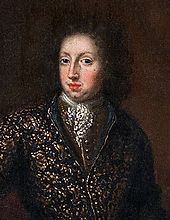
In 1691, Rehnskiöld traveled to the Netherlands as a military observer. He also tutored Prince Frederick IV of Holstein-Gottorp. He reported back to King Charles XI about the war against France.
When he returned to Sweden in 1693, Rehnskiöld became Colonel of the Scanian Cavalry Regiment. In 1696, he was made a Major-General of cavalry. After General von Ascheberg died, Rehnskiöld became King Charles XI's main military expert. He helped improve the army's training and organization. His regiment became a model for the Swedish cavalry.
When King Charles XI died in 1697, his son Charles XII became King. The new King made Rehnskiöld a Baron and appointed him Governor-General of Scania. He also became a Lieutenant-General of cavalry.
Rehnskiöld was very important in developing the Carolean combat tactics. These tactics were based on older Swedish fighting styles, focusing on strong attacks. Rehnskiöld taught King Charles XII about these methods. He believed infantry (foot soldiers) should be organized into groups of 600 men. They would march quickly and attack with pikes and swords after firing their muskets up close. Cavalry (horse soldiers) would charge in tight groups at full speed. This was different from other European armies at the time. Swedish units were often made up of men from the same region, which helped them form strong bonds. Strict discipline and high morale were kept through their Christian faith and loyalty to the King.
As Governor-General, Rehnskiöld managed land and forests in Scania. He also helped prepare the kingdom for a possible war with Denmark. He believed that border areas should be strongly defended. He also thought the Swedish Navy needed to control the Baltic Sea for troop movements and supplies. In 1700, he formed his own elite cavalry unit, the Life Dragoon Regiment.
On January 17, 1697, Rehnskiöld married Elisabeth Funck. They had a daughter in 1699, but she died young. Rehnskiöld then left Sweden to fight in the Great Northern War.
The Great Northern War (1700–1709)
Campaigns in Denmark and the Baltics
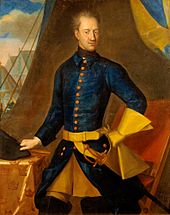
The Great Northern War started on February 12, 1700. The King of Poland and Elector of Saxony, Augustus II, attacked the Swedish city of Riga. At the same time, King Frederick IV of Denmark invaded Holstein-Gottorp.
Sweden mobilized its army. Rehnskiöld was put in charge of the army's deployment in Scania. He also became the leader of the King's main army headquarters. King Charles XII decided to deal with Denmark first.
In July 1700, the Swedish army planned to land troops on Zealand, a Danish island. Rehnskiöld helped plan the landing at Humlebæk. On July 25, the landing happened with support from the Swedish navy. Rehnskiöld led the left side of the landing forces. The Danish defenders were quickly defeated. This forced King Frederick IV to make peace on August 8, 1700.
After Denmark left the war, the Swedish army moved to the Baltic front. King Charles XII learned that Russian troops were besieging the Swedish outpost of Narva in Estonia. The Swedish army sailed from Karlshamn to Pernau in Estonia in October. On November 13, the Swedish army, about 11,000 men, marched towards Narva. Many officers thought this was too risky because the Russian army was much larger.

Rehnskiöld helped plan the attack on Narva. The Swedes would attack with two columns of soldiers against the middle of the Russian defenses. Each column would then move along the Russian line, trapping the enemy against the Narva River. Rehnskiöld led the left column.
On the afternoon of November 20, the Swedish columns attacked. A heavy snowstorm helped hide the Swedes and blew into the Russians' faces. The Swedes broke through the defenses, causing panic among the Russian troops. The Russian army surrendered and was allowed to leave. The Russians lost about 9,000 men, and their commanders were captured. The Swedes lost about 1,900 men. This victory greatly impressed other European nations.
Campaign in Poland
The Swedish army spent the winter near Laiuse Castle. In the spring, more soldiers arrived from Sweden, making the army 24,000 strong. In June, they marched south to attack Augustus II's Saxon-Russian army near Riga. On July 7, the Swedish army was outside Riga. Charles XII and Rehnskiöld planned to cross the Düna river.
On the morning of July 9, about 3,000 Swedish troops rowed across the river. The Swedes used burning boats to block the enemy's view. Rehnskiöld helped transport his cavalry across the river using rafts. The Swedish infantry established a foothold and fought off Saxon attacks. Augustus II retreated, losing about 2,000 men. The Swedes lost 500. The crossing was a success, but it didn't lead to a decisive victory.
Since Augustus II wasn't decisively defeated, Charles XII decided to invade Poland to weaken him. In July 1702, Charles XII and his army found Augustus II near Kliszów. Rehnskiöld advised the King to wait for more troops, which arrived on July 8. Rehnskiöld helped plan the battle. Augustus had about 24,000 Saxon-Polish troops in a strong position. The Swedish army had 12,000. The main Swedish force would try to go around the Saxon right side. Rehnskiöld's right wing would defend against the Saxon attack.
On the morning of July 9, the Swedish troops attacked. The Polish cavalry attacked the Swedish left side, but the Swedes managed to defeat them. Rehnskiöld successfully held off the Saxon attack. The main Swedish forces captured the Saxon artillery and threatened to surround the Saxon center. Augustus II had to retreat, losing about 4,000 men. The Swedes lost about 1,100 men. Rehnskiöld's nephew and Prince Frederick IV of Holstein-Gottorp were among the dead.
Charles XII couldn't completely destroy Augustus II's army, so Augustus could gather new troops. Charles XII then spent time in Poland trying to get Polish nobles to remove Augustus II as King. In December 1702, Rehnskiöld was given command of about 10,000 men. His job was to protect negotiations in Warsaw and gather supplies for the Swedish troops besieging Thorn. In April 1703, Rehnskiöld was promoted to General of cavalry. In February 1704, the Warsaw Confederation agreed to remove Augustus II as King. Rehnskiöld helped protect their meetings.
War in Saxony
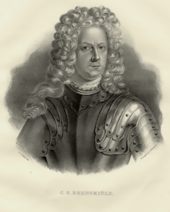
In the summer of 1705, Rehnskiöld commanded an army of about 10,000 men in Greater Poland. His task was to protect King Charles XII's army from Augustus II's Saxon army, which had 25,000 men. Rehnskiöld moved his army closer to the Saxon border. In December, Charles XII made him a Royal Councillor and a Field Marshal. Rehnskiöld didn't find out about this until August 1706.
In January 1706, Rehnskiöld learned that the Saxons planned a two-part attack on his army. He quickly decided to attack the Saxon army under Field Marshal Johann Matthias von der Schulenburg before Augustus II could arrive. On January 31, Rehnskiöld reached Fraustadt. Schulenburg's army was already there, in a strong position with 16,000 infantry and 4,000 cavalry. Rehnskiöld had only 9,400 soldiers. He planned a risky attack with a weak center and two strong cavalry wings. Rehnskiöld himself led the right wing.
The battle began at noon on February 3, 1706. The Swedish cavalry wings charged the Saxon flanks and defeated their cavalry. The Swedish wings then surrounded the Saxon-Russian center, which quickly broke apart. Schulenburg managed to escape, but most of his army was captured or killed. After two hours, about 7,377 Saxon soldiers were killed and 7,300-7,900 were captured. The Swedes lost 400 killed and 1,000 wounded. Many captured Saxon soldiers were later used in the Swedish army.

The victory at Fraustadt had a huge impact across Europe. In June, Rehnskiöld was made a Count. With the main Saxon army defeated, the Swedish army could move into Saxony. In August, Charles XII joined Rehnskiöld's army. They occupied Saxony without resistance. The Treaty of Altranstädt (1706) was signed on September 14. Augustus II had to break ties with his allies and give up his claim to the Polish throne.
The Swedish army stayed in Saxony for a year. Charles XII's headquarters became a center for European politics. Many important people visited. The famous English General, the Duke of Marlborough, convinced Charles XII not to get involved in the War of the Spanish Succession. Charles XII then prepared his army to march east towards Russia.
Campaign in Russia
In August 1707, the Swedish army, about 40,000 strong, marched east towards Russia. Rehnskiöld was the Field Marshal and closest to the King in command. The King kept his exact plans secret, but they aimed for Moscow. Charles XII ordered General Adam Ludwig Lewenhaupt to join the main army with supplies. The main army moved slowly. In January 1708, they reached Grodno, which was held by 9,000 Russian soldiers. Charles XII and Rehnskiöld attacked with 800 cavalry, and the Russians retreated. Later, during the battle of Holowczyn in July 1708, Charles XII led the infantry and Rehnskiöld led the cavalry. The Russians were pushed back, but they escaped mostly intact.
Lewenhaupt's army was delayed and attacked by a Russian army. He had to burn most of his supplies. In October, Lewenhaupt finally joined the main army with only 6,500 men and no supplies.
Rehnskiöld had a strong rivalry with Count Carl Piper, who was the King's chief civilian official. Both wanted the King's favor. Piper wanted the King to be careful, while Rehnskiöld supported the King's aggressive plans. Their arguments caused problems within the Swedish headquarters.
The army suffered from a lack of food. The Russian Tsar, Peter I, used a "scorched earth" tactic, burning everything so the Swedes couldn't find supplies. Charles, Rehnskiöld, and other leaders decided to go south to Little Russia (modern-day Ukraine). They hoped to get supplies and help from Ivan Mazepa, the leader of the Zaporozhian Cossacks.
However, Peter I attacked Mazepa's capital, and Mazepa lost much of his support. He could only bring a few thousand Cossacks to the Swedes, not the large army and supplies he promised. In December 1708, during a very cold winter, thousands of soldiers died from the cold. The Swedish army besieged the fortress of Veprik, held by 1,500 Russians. On January 7, 1709, Rehnskiöld led the attack. He planned to bombard the walls and then have three columns of 3,000 men climb over the walls. The first attack failed. During the second attack, Rehnskiöld was hit in the chest by a bullet. He had to hand over command. This attack also failed, but the Russians, low on ammunition, surrendered. The Swedes lost 1,000 killed and 600 wounded. Rehnskiöld slowly recovered, but his injury never fully healed.
The Swedish army moved south to Poltava. In May 1709, Charles XII laid siege to Poltava to draw the Russians into battle. The city had a 4,200-man garrison. Peter I marched to relieve the city with 74,000 Russian soldiers. On June 17, Charles XII was shot in the foot and couldn't stand. This encouraged the Tsar to fight a field battle. Peter I built strong defenses with ten redoubts (small forts). Despite his injury, Charles XII ordered Rehnskiöld to attack.
Battle of Poltava
At Poltava, the Swedes had about 16,000 soldiers, and the Russians had 40,000. Rehnskiöld took command because the King was injured. Lewenhaupt led the infantry, and Major-General Carl Gustaf Creutz led the cavalry. Rehnskiöld and the King planned the battle. The Swedish infantry, about 8,170 strong, was divided into four columns. They would make a surprise attack on the Russian redoubts before dawn. The cavalry, about 7,800 strong, would follow. After passing the redoubts, the Swedes would march to an open field in front of the Russian camp. The Swedish cavalry would drive off the Russian cavalry. From there, the Swedish army would form up and trap Peter's army against the river.
Shortly before midnight on June 28, Rehnskiöld ordered his troops to advance. The Russians discovered the Swedes and sounded the alarm, so the surprise was lost. Rehnskiöld ordered the infantry to continue. It was daylight, and the Swedes saw the entire Russian cavalry behind the redoubts. The Swedish cavalry fought them off. The Swedish infantry then marched towards the redoubts. Some were captured quickly, but attacks on others caused heavy losses. One column had to retreat and later surrendered. The other columns passed the redoubts, but Rehnskiöld had already lost one-third of his infantry. The Swedish cavalry had chased the Russian cavalry far past the camp. Rehnskiöld ordered the Swedish cavalry to stop chasing and rejoin the infantry.
At nine o'clock, the Russian infantry marched out. About 4,000 Swedish soldiers faced 22,000 Russian soldiers. Rehnskiöld ordered Lewenhaupt to attack the Russian lines. But the Swedish cavalry didn't arrive in time, and the Swedish infantry was defeated. The King, Lewenhaupt, and most of the cavalry escaped. Rehnskiöld, Piper, and the remaining infantry were captured by the Russians. About 6,900 Swedes were killed or wounded, and 2,800 were captured. The Russians lost 1,345 men.
A few days later, Lewenhaupt and 20,000 remaining Swedish soldiers surrendered. The King, Mazepa, and about 1,000 men managed to escape to the Ottoman Empire. The Battle of Poltava was a major defeat for Sweden. Denmark-Norway and Saxony-Poland rejoined the war against Sweden. Other countries also joined the alliance. This battle marked the beginning of Sweden's final defeat in the war.
Historians have discussed Rehnskiöld's leadership at Poltava. Some say he was under great stress. He made some mistakes, like not properly scouting the new Russian redoubts and not fully informing his officers of his plan. Also, his decision to stop the Swedish cavalry's pursuit of the retreating Russian cavalry is debated. Some say it was a mistake that could have changed the battle's outcome.
Prisoner of War (1709–1718)
Soon after the battle, Rehnskiöld and other captured Swedish officers were taken to the Russian camp. Rehnskiöld, Carl Piper, and four Swedish generals met Tsar Peter I. The Tsar asked about the King's health, as he thought Charles XII might be dead. Rehnskiöld said he believed the King was alive and well. Pleased, Peter returned Rehnskiöld's sword. Later, the Tsar held a dinner with the captured generals, asking them questions and toasting them as his "teachers in the art of war."
In late 1709, Rehnskiöld and the captured Swedish army were taken to Moscow. Peter I held a huge victory parade on December 22. After the parade, the Swedish prisoners were sent to different cities and prison camps across Russia. Rehnskiöld and Piper lived in a house in Moscow. They sometimes argued, with Piper blaming Rehnskiöld for the loss at Poltava.
Later, Rehnskiöld and Piper decided to work together to help the Swedish prisoners. They set up an office in Moscow to communicate with Swedish authorities and raise money for the prisoners. However, money from Sweden became harder to get.
Because of the lack of support from Sweden, Rehnskiöld and the officers had to ask the Tsar for help in 1714. The Tsar made conditions harder for the Swedish officers. Piper was imprisoned and died in 1716. Rehnskiöld had to manage the office alone. He wrote letters to Sweden about the suffering of the prisoners. He also helped organize religious services for the prisoners.
In 1718, efforts began to get Rehnskiöld released. Russia and Sweden started peace talks. Rehnskiöld was involved in discussions about who would be the next King of Sweden, as Charles XII had no children. On October 30, Rehnskiöld was finally released in an exchange for Russian generals.
The Last Years (1718–1722)

After his release, Rehnskiöld went to Stockholm. Then he traveled to King Charles XII's headquarters in Norway, where the King was besieging the fortress of Fredriksten. Rehnskiöld arrived in late November 1718. He had a long talk with the King about the war and peace talks. Two days later, on November 30, Charles XII was shot and killed. Prince Frederick, who was in command, decided the army should abandon the siege and return to Sweden. Rehnskiöld signed the report about the King's death. Prince Frederick also ordered the arrest of Georg Heinrich von Görtz, a key advisor, who was later executed. With Görtz's death, peace talks with Russia stopped, and the war continued.
In January 1719, Rehnskiöld received a large sum of money from Prince Frederick. This was seen as a reward for his time as a prisoner. Rehnskiöld later joined the Privy Council in Stockholm. He helped carry the royal spire during King Charles XII's funeral on February 26.
|
Promotions
|
Because Sweden was very weak, Rehnskiöld was made commander in western Sweden. His job was to protect these areas from Danish attacks. He inspected cities and fortresses, strengthening their defenses. In July, Danish forces landed at Strömstad. Rehnskiöld had 5,000 men and ordered them to burn supplies so the Danes couldn't get them. He fortified his position in Uddevalla. The Danish-Norwegian army eventually returned to Norway. Rehnskiöld then went to Scania to defend it. An armistice was agreed with Denmark on October 28, 1719, and a peace treaty was signed on July 3, 1720.
On August 30, 1721, the war finally ended with Russia through the Treaty of Nystad. Sweden lost its status as a major power in Europe. When Ulrika Eleonora became Queen in 1719, she wanted her husband, Frederick, to be co-ruler. She later stepped down, and on March 24, 1720, Frederick became King. He was crowned Frederick I on May 3. As the oldest member of the Privy Council, Rehnskiöld helped place the crown on Frederick's head.
In January 1722, King Frederick I called Rehnskiöld to Kungsör. Rehnskiöld became ill during the journey. He was taken to an inn outside Mariefred. He had a high fever and was spitting blood, likely from his old shrapnel injury from Veprik. He died on January 29, 1722. His funeral was held on March 15 in Stockholm. Rehnskiöld's wife, Elisabeth, remarried in 1724 and died in 1726.
See also
 In Spanish: Carl Gustav Rehnskiöld para niños
In Spanish: Carl Gustav Rehnskiöld para niños
- List of Swedish field marshals



